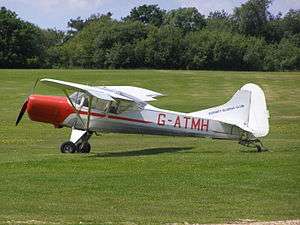Beagle Husky
| Husky | |
|---|---|
 | |
| Role | Utility aircraft |
| Manufacturer | Auster, Beagle Aircraft, OGMA |
| First flight | 10 January 1960 |
| Number built | 150 |
| Developed from | Auster Alpha |
The Beagle A.113 Husky (originally, the Auster D.5) was a three-seat British light aircraft built in the 1960s, a development of the Auster Alpha. It first flew as an Auster design in January 1960, but that company was taken over by Beagle Aircraft in September. It was initially available with a 160 hp Lycoming O-320 engine and 133 examples (Auster D.5/160) were built by the Oficinas Gerais de Material Aeronáutico in Portugal from 1961 onwards; and the Portuguese Air Museum preserves two of these; one in flying condition.[1][2] Subsequently, Beagle developed the D5/160 as the "Beagle D5/180 Husky" with a 180 hp Lycoming O-360 engine, the first being G-ASBV first flown in 1962. A small number were sold until production was discontinued in 1967.
The designation "A.113" was only a design number and was not used in promotional material or in aircraft registrations with the Civil Aviation Authority where the term 'D5/180' was preferred. Additionally, the name Husky was only given to this version and not to the D5/160.
Operators

- Royal Thai Police
- Thai Border Patrol Police - One aircraft only.
- Royal Air Force – One Beagle Husky (XW635) was won by Sir Billy Butlin in a raffle and presented to the RAF's Air Training Corps in 1969. It flew with No. 5 Air Experience Flight, flying air cadets from Cambridge Airport until it was retired in 1989 and sold to a civilian user.[3][4]
Specifications (D.5/160)
Data from British Civil Aircraft since 1919: Volume I[5]
General characteristics
- Crew: one pilot
- Capacity: 2 passengers
- Length: 23 ft 4½ in (7.13 m)
- Wingspan: 36 ft 0 in (10.98 m)
- Height: 7 ft 11 in (2.41 m)
- Wing area: 185 ft² (17.2 m²)
- Empty weight: 1,450 lb (659 kg)
- Loaded weight: 2,450 lb (1,114 kg)
- Powerplant: 1 × Lycoming O-320-A2A, 160 hp (119 kW)
Performance
- Maximum speed: 125 mph (109 knots, 201 km/h)
- Cruise speed: 108 mph (94 knots, 174 km/h)
- Range: 460 mi (400 nmi, 741 km)
- Service ceiling: 12,800 ft (3,900 m)
- Rate of climb: 640 ft/min (3.3 m/s)
See also
- Related development
References
- ↑ ex-OGMS: Aviões da FAP – Auster
- ↑ Auster Production List
- ↑ "Beagle D-5/180 Husky aircraft". airliners.net. Retrieved 7 September 2010.
- ↑ "UK Serials (XW)". ukserials.com. UK Serials Resource Centre. Retrieved 7 September 2010.
- ↑ Jackson 1974, p. 188.
Further reading
| Wikimedia Commons has media related to Beagle Husky. |
- Jackson, A. J. (1974). British Civil Aircraft since 1919 Volume I. London: Putnam. ISBN 0-370-10006-9.
- Taylor, Michael J. H. (1989). Jane's Encyclopedia of Aviation. London: Studio Editions. p. 85.
- Simpson, R. W. (1995). Airlife's General Aviation. Shrewsbury: Airlife Publishing. p. 43.